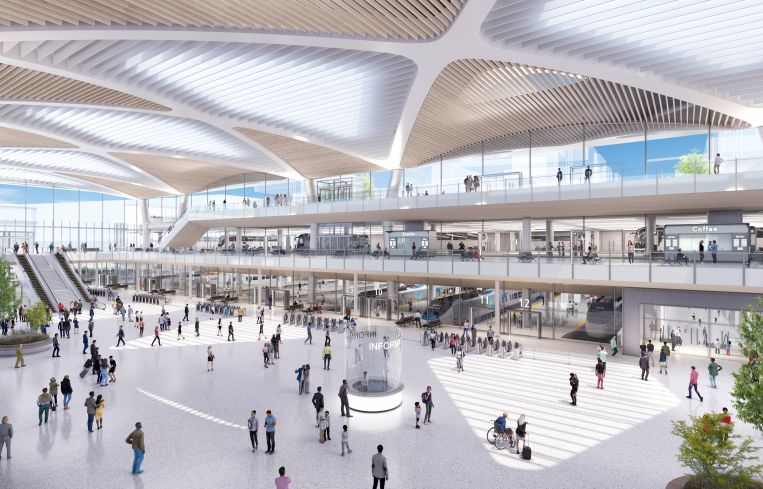$8.8B Union Station Redevelopment Plan Wins Key Approval
Project leads can now seek funding for pre-construction design and planning
By Nick Trombola March 15, 2024 3:46 pm
reprints
The ribbon-cutting ceremony may not happen for years — or even decades — but Washington, D.C.’s Union Station redevelopment project just got one step closer to becoming a reality.
The Federal Railroad Administration (FRA) signed off on the final environmental impact assessment for the proposed revitalization of the station Thursday.
The project is estimated to cost $8.8 billion throughout its 13-year development cycle. The redevelopment aims to add an entirely new rail terminal with four new concourses, plus a new bus facility, pedestrian throughway and new retail spaces. The FRA’s approval means that the nonprofit Union Station Redevelopment Corporation (USRC), which helms the project in coordination with Amtrak, can begin securing funding for the more detailed design and planning phases.
“This is an important milestone for the future transformation of Union Station. As sponsor of this once-in-a-lifetime project, we realize this is just the first of several significant steps ahead of us,” USRC CEO and President Doug Carr told Commercial Observer. “It’s important to understand that the project is at the preliminary design phase. It now must be translated into reality, and so the next phase of hard work, bolstered by outside support, begins.”
Before taking the head role at USRC, Carr oversaw New York City’s Moynihan Train Hall redevelopment between 2018 through 2022. That project, which overhauled the city’s James A. Farley Post Office building, began in 2010 and was fully opened in early January 2021.
With Union Station’s hoped-for completion date of 2040, construction would need to begin by 2027 at the latest. Yet the project is already behind schedule and the all-important matter of funding is still up in the air, especially as the District, and the regional transportation authority (Metro) in particular, faces severe budget shortfalls. The project could potentially take advantage of money earmarked for Amtrak expansion via the $1.2 trillion infrastructure bill signed by President Biden in 2021, though USCR can’t apply for those funds until the pre-construction phase is complete.
The station’s facelift isn’t the only project at stake. If and when construction commences, it would by proxy allow an adjacent 3.7 million-square-foot mixed-use development, dubbed Burnham Place, to also proceed. That project, in the oven for more than two decades, would add up to a dozen buildings along 15 acres of airspace that developer Akridge owns above the station’s train tracks.
Union Station opened in 1907 and is owned by the federal government, but overseen by and leased to other organizations and institutions. Amtrak owns the station’s tracks and platforms, while the government picked USRC to manage the historic station back in 1985. The redevelopment project would preserve the station’s main hall and rotunda, which was added to the National Register of Historic Places in 1973. The station is the 10th-busiest railroad hub in North America, with about 40 million annual visitors.
The FRA’s assessment also notes a number of challenges inevitably caused by the redevelopment effort. Nearly 3 acres of Akridge’s air rights would need to be acquired for the new station, the report says, along with temporary road closures, years-long construction traffic and a severe reduction of parking revenue once the station’s existing parking garage is demolished to make way for a much smaller underground complex.
Yet the benefits of the project far surpass the downsides, the report said, including enhancing ridership capacity, renovating ADA-compliant train platforms and beefing up security. Union Station’s redevelopment is a major component of regional economies for Maryland and Virginia, as well as D.C., and supports the broader national goal of creating a “world-class” national passenger rail system in the nation’s capital, according to USRC.
“The project is needed to improve rail capacity, reliability, safety, efficiency, accessibility and security for both current and future long-term railroad operations,” the FRA report said.
Nick Trombola can be reached at NTrombola@commercialobserver.com.


